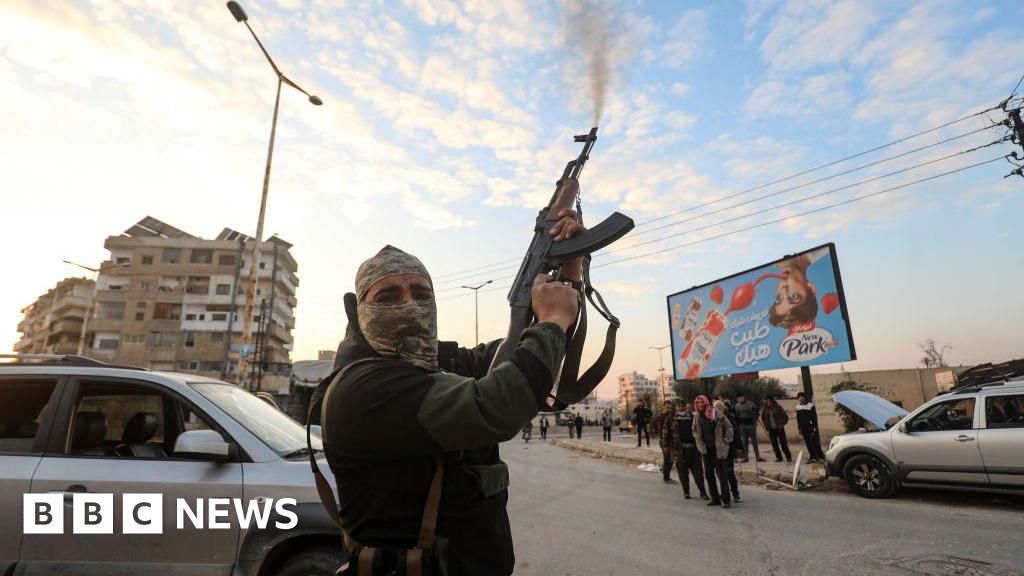
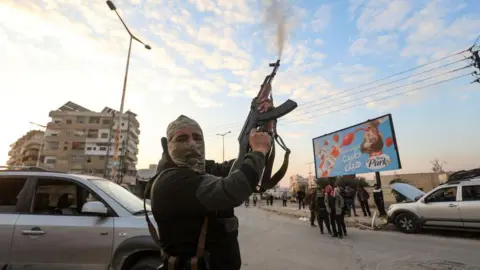 AFP
AFPSyrian rebels say they have taken full control of a second major city, after the military withdrew its troops from Hama in another setback for President Bashar al-Assad.
The leader of the Islamist militant group Hayat Tahrir al-Sham (HTS), Abu Mohammed al-Jawlani, declared “victory” in Hama and vowed there would be “no revenge”.
Earlier, HTS fighters and their allies took over Hama central prison and released inmates amid fierce battles, while the military said it had redeployed troops outside the city.
Hama is home to one million people and is 110km (70 miles) south of Aleppo, which the rebels captured last week after launching a surprise offensive from their stronghold in the north-west.
The rebel commander told residents of Homs, which is the next city south on the highway from Aleppo to Damascus, that “your time has come”.
In the past, President Assad relied on Russia and Iran to crush his opponents.
But with both allies preoccupied with their own affairs, it is unclear how – or if – he will be able to stop an advance that could threaten his government’s survival.
More than half a million people have been killed since a civil war erupted in 2011 after Assad’s government cracked down violently on peaceful pro-democracy protests.
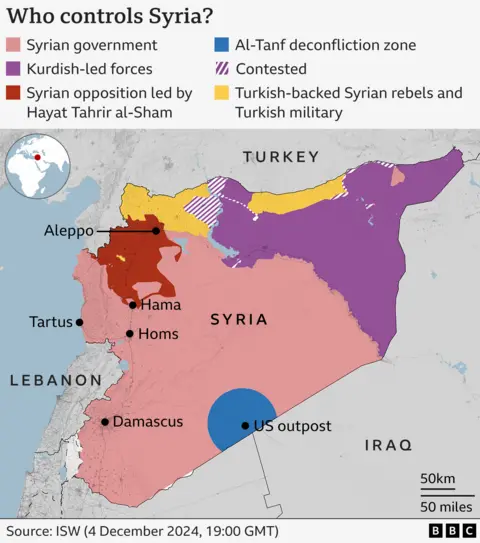
The rebels broke through the government’s defensive lines north of Hama following several days of heavy fighting.
The military had sent reinforcements to the city after the fall of Aleppo. But despite support from Russian air strikes and Iran-backed militia fighters, troops were unable to prevent Hama being overrun on Thursday.
Rebel commander Hassan Abdul Ghani said in the morning that its fighters were engaged in fierce battles in various districts.
In the early afternoon, he announced that hundreds of inmates from Hama’s central prison had been released.
Minutes later, the military announced the redeployment of troops outside Hama “to preserve civilian lives and prevent urban combat”.
Photos and videos posted online and verified by the BBC showed fighters in several north-eastern neighbourhoods. The freed inmates were also filmed celebrating outside the central prison with a rebel and a reporter for a pro-opposition news outlet.
Abdul Ghani subsequently declared: “We’re pleased to tell you that Hama has been completely liberated after our forces have finished combing operations.”
He also said the rebels had cleared Hama military airport, in the city’s western outskirts, as well as Jabal Zain al-Abadin, a strategically important hill just to the north-east that overlooks the Damascus-Aleppo highway.
In a video, Abu Mohammed al-Jawlani said his fighters had entered Hama to “cleanse the wound that has endured in Syria for 40 years”.
“I ask God almighty that it be a conquest with no revenge,” he added.
The HTS leader was referring to the killing of between 10,000 and 25,000 people in the city in 1982, when the late President Hafez al-Assad sent in tanks and artillery to crush an Islamist uprising.
Similar tactics have been employed across the country by his son, Bashar, over the past 13 years.
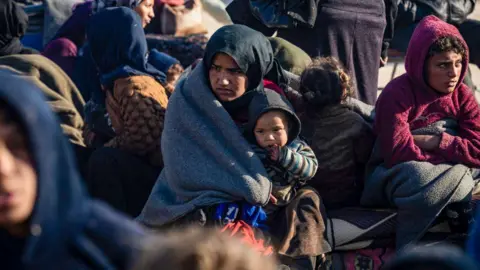 AFP
AFPThe Syrian Observatory for Human Rights (SOHR), a UK-based monitoring group, says more than 820 people – most of them combatants, but also including 111 civilians – have been killed across the country since the start of the rebel offensive eight days ago.
The UN has said the fighting is also “worsening an already horrific situation for civilians in the north of the county”.
An estimated 280,000 people have been displaced, most of them women and children, and some civilians are trapped in front-line areas unable to reach safer locations.
In Aleppo, home to two million people, some public services and critical facilities – including hospitals, bakeries, power stations, water, internet and telecommunications – are meanwhile disrupted or non-functional because of shortages of supplies and personnel.
UN Secretary-General Antonio Guterres urged “all those with influence to do their part” to end the civil war.
“We are seeing the bitter fruits of a chronic collective failure of previous de-escalation arrangements to produce a genuine nationwide ceasefire or a serious political process,” he added. “These must change.”
President Assad has vowed to “crush” the rebels and accused Western powers of trying to redraw the map of the region, while his key allies Russia and Iran have offered their “unconditional support”.
Russian warplanes have intensified their strikes on rebel-held areas in recent days, Iran-backed militias have sent fighters to reinforce the government’s defensive lines, and Iran has said it is ready to send additional forces to Syria if asked.
Turkey, which supports the Syrian opposition but has denied reports that it is involved in the HTS-led offensive, has urged Assad to engage in a political process with the opposition to bring an end to Syria’s 13-year civil war.
Turkish-backed rebel factions have meanwhile capitalised on the government’s retreat in the north by launching a separate offensive on a pocket of territory near Aleppo that was controlled by a Kurdish-led militia alliance, the Syrian Democratic Forces (SDF). Turkey, which has a large restive Kurdish minority, considers the Kurds in Syria as a threat.
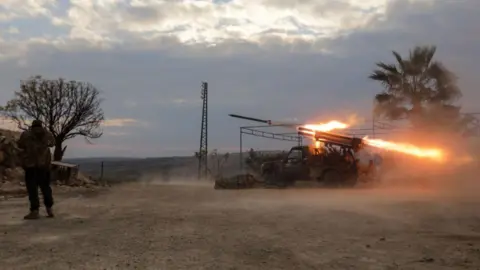 AFP
AFPBefore the start of the rebel offensive, the government had regained control of Syria’s main cities with the help of Russia, Iran and Iran-backed militias. However, large parts of the country remained out of its control.
The rebels’ last stronghold was in Aleppo and Idlib provinces, which border Turkey and where more than four million people were living, many of them displaced from government-held areas.
The enclave was dominated by HTS, which is designated as a terrorist organisation by the UN, US, Turkey and other countries because it was al-Qaeda’s affiliate in Syria until it formally broke ties in 2016.
A number of allied rebel factions and jihadist groups were also based there, along with Turkish-backed SNA factions and Turkish forces.
HTS and its allies said on 27 November that they had launched an offensive to “deter aggression”, accusing the government and allied Iran-backed militias of escalating attacks on civilians in the north-west.
But it came at a time when the government’s allies were preoccupied with other conflicts.
The Iran-backed Lebanese group Hezbollah, which was crucial in helping push back rebels in the early years of the war, has suffered recently from Israel’s offensive in Lebanon. Its new leader Naim Qassem said on Thursday that it would “be by Syria’s side in thwarting the goals of this aggression as much as we can”.
Israeli strikes have also eliminated Iranian military commanders in Syria and degraded supply lines to pro-government militias there.
Russia has also been also distracted by the war in Ukraine.




